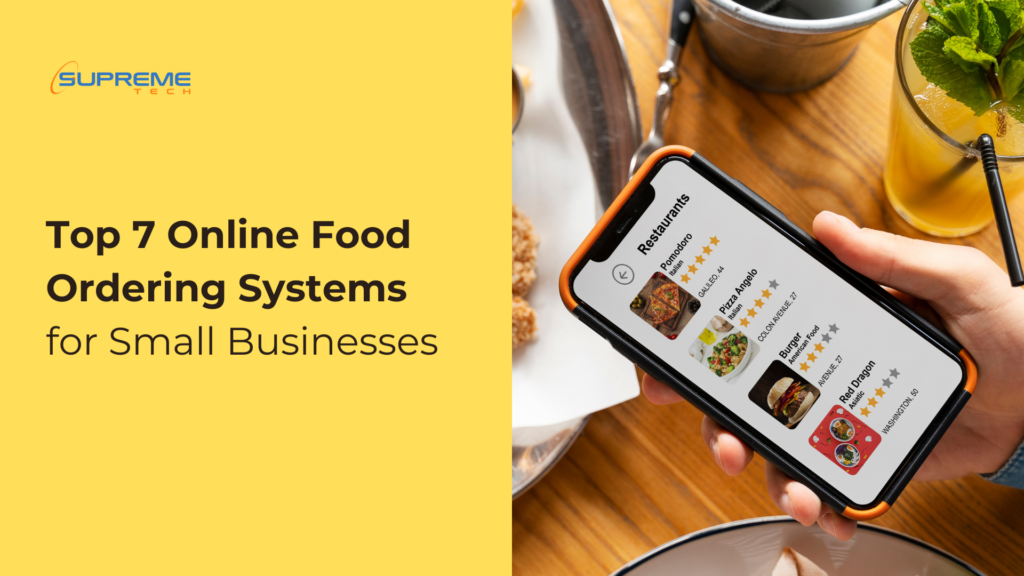Exploring 7 Top Online Food Ordering Systems for Small Businesses
03/05/2024
2.71k
After the Covid-19 pandemic, the convenience of online food ordering has become blatant for both consumers and businesses. SMEs, including independent restaurants and food establishments, are seeking for online ordering systems to expand their reach and boost sales. In this article, we’ll explore seven popular online food ordering systems tailored for SMEs.
With a jumble of options available, it’s essential for SMEs to choose the right online food ordering system that aligns with their specific needs and budget. Hopefully, this article may help in making the right decision.

What is online food ordering system?
Online food ordering system is a digital platform that enables customers to buy food online. Some common features include browse menus, select dishes, customize order & delivery, and payment. On the other side, restaurant owners can easily manage and serve their customers accordingly.
Though the list of feature may vary from each system to another, these are some key components of a typical food ordering system:
- Menu Management
- Order Placement
- Payment Processing
- Order Fulfillment
- Order Tracking
- Customer Accounts
- Feedback and Reviews
- Analytics and Reporting
We will dig deeper into each component in the upcoming blogs.
Why using online food ordering system?
With the dominance of food ordering services like ShopeeFood or GrabFood and its undeniable advantages, a question should be (or must be) asked: Why should SMEs use an independent ordering system?
Lower commission rates
Third-party delivery platforms often charge significant commission fees, which can eat into the profit margins of SMEs, particularly those with smaller-scale operations. Therefore, using other online food ordering systems that offer flat-rate pricing or commission-free options can be more cost-effective for SMEs.
Less dependency
Relying solely on third-party platforms for online food ordering can create a dependency on these platforms for business growth. By diversifying their online presence and using other ordering systems, SMEs can maintain more control over their online sales channels.
Overall, third-party platforms remain a good choice for motorbike-friendly country. But who knows what the future holds?
Top 7 online food ordering systems
The availability of online food ordering systems has altered the way SMEs operate and interact with their customers. By leveraging the right online ordering platform, SMEs can streamline operations, improve customer experience, and drive sales growth.
1. Square Online Ordering
Square Online Ordering is a feature of Square, a comprehensive platform that provides tools for businesses to manage various aspects of their operations, including point-of-sale (POS), payments, and online ordering. It seamlessly integrates with Square’s comprehensive platform. With customizable ordering pages, menu management tools, and real-time order notifications, Square empowers SMEs to offer a branded and efficient online ordering experience to their customers.
2. Toast POS
Toast POS is primarily a point-of-sale (POS) system designed specifically for restaurants. But it also offers online ordering capabilities as part of its platform. Overall, Toast POS offers a robust and integrated solution for restaurants looking to manage both in-person and online orders effectively. Toast enables SMEs to streamline operations and provide seamless offline-merge-online ordering options to their customers.
3. ChowNow
ChowNow is a commission-free online ordering platform that caters to independent restaurants and small chains. With custom-branded ordering apps and websites, menu management tools, and CRM features, ChowNow empowers SMEs to create a personalized and cost-effective online ordering experience for their customers.
4. GloriaFood
GloriaFood offers a free online ordering system for restaurants, cafes, and food trucks, making it an attractive option for budget-conscious SMEs. With customizable ordering widgets and integration with social media platforms, GloriaFood enables SMEs to easily set up and manage their online ordering presence.
5. Online Ordering System by Shopify
Shopify’s online ordering system allows SMEs to create their own branded online store with integrated ordering functionality. One main advantage of Shopify Online Ordering System is its integration and customization possibilities for Shopify stores. It’s easy to choose an existing Shopify app and customize it to your tailored needs.
Looking for a custom Shopify Online Ordering App? Maybe we can help!
6. Lightspeed
Lightspeed offers a POS system with online ordering capabilities, designed to help small and mid-sized restaurants manage their operations more efficiently. With features such as menu management, order tracking, and integration with delivery services, Upserve enables SMEs to optimize their online ordering strategy and enhance customer satisfaction.
7. MenuDrive
MenuDrive specializes in providing online ordering solutions for small and independent restaurants. With customizable online ordering websites, menu management tools, and integration with POS systems, MenuDrive empowers SMEs to create a branded and user-friendly online ordering experience for their customers.
Which one is the best choice?
In conclusion, while platforms like GrabFood and ShopeeFood can offer valuable exposure and access to a large customer base, SMEs should carefully weigh the pros and cons. Also, business owners should consider their specific business goals and needs before deciding which online food ordering systems to use. Ultimately, choosing the right platform or combination of platforms can help SMEs maximize their online sales and grow their business effectively.






















